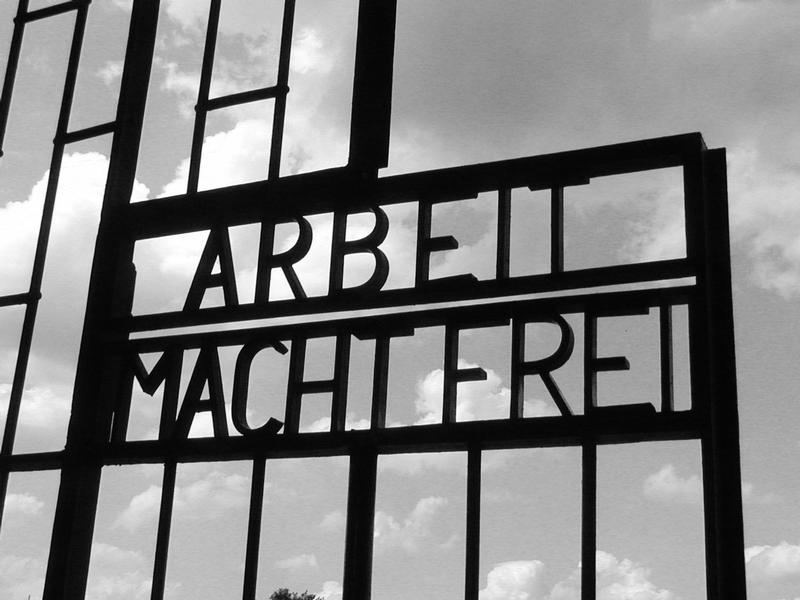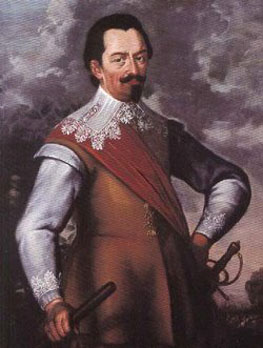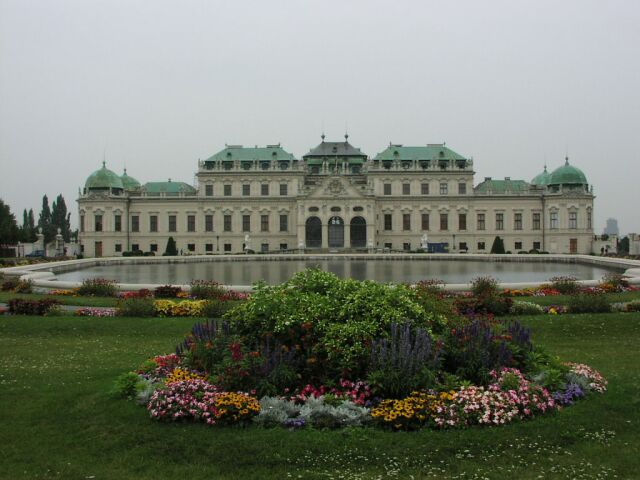
photo: courtesy of google images
Just 20 minutes outside of Munich, lies one of Germany’s darkest places:

Dachau Concentration Camp, where prisoners, Jews, homosexuals, and Russians were subjected to inhuman amounts of work, physical, and psychological torture. The entrance is an iron gate with the words: Arbeit macht frei, on it, meaning “work will set you free.” These words were deceitful, for it made the prisoners believe that the more and harder they worked the sooner they would be set free; however, that was not the case. The harder they worked in the terrible conditions they were given, with little amounts of food, meant that the harder they worked the weaker they became and when they became too weak to work they would be sent to the death camps. They truly had no way out once they entered into Dachau, the only way out was death. After entering the gate, one can see that the Nazis created an environment of desolation and hopelessness for its prisoners. It is completely barren with gravel walkways and white buildings. Just inside the fence there is a small border of grass called “no man’s land” if any prisoner was seen on the grass, they would be considered to be trying to escape and would be shot from one of the guard towers.

Often times the SS would play sick games with the prisoners, for example: all prisoners were required to wear a cap at all times. The guards would take off the prisoner’s cap and throw it into no man’s land, then tell them to go get it. If they ignored the guard’s orders they will be severely punished and if they go into no man’s land they will get shot. The SS would often play disgusting games such as this in which the prisoners could not win.
Another sick rule they made was: all the prisoners were issued uniforms that had pockets and anyone who placed their hands inside their pockets would be shot. In the winter, temperatures would often reach -10 C and the prisoners had to wear these thin uniforms and work long days outside without gloves on, so an inherent and natural warming technique would be to put their hands in their pockets; however, if they did they would get shot. So one would think, why even put pockets in their uniforms if they were not allowed to use them?
The death toll estimates at Dachau are about 60-70,000, which is low considering they did not account for Jewish or Soviet deaths from 1943-1935, at the height of the camp’s operation. Dachau was the first concentration camp of the Nazi regime and prisoners were sent here to work on armament for the Nazi forces. Dachau was opened in 1933 and started receiving 2,000 prisoners yearly. It capacity was for about 2,000 prisoners; however at the height of its operation it had around 200,000 prisoners working well over its maximum capacity.
Once prisoners reached Dachau, they would have to register and check in where they were treated poorly and beat by screaming SS officers. They would then have to strip naked and get all the hair on their body shaved off; however, the instrument used to shave off their hair was not gentle and would basically just rip off the hair right out of their skin, leaving open sores. Then they were required to take a shower in an alcoholic liquid to remove their impurities from their body, with the open sores from their hair being ripped out made it very painful.
After the shower they were then rushed to pick their uniform. The prisoners were not given any time to pick sizes, if they did not get their uniforms quickly enough they would be punished and beat. So the prisoners would just grab whatever they could, often choosing pa

nts that were too big and shirts that were too small. They would then get punished and beat for not picking a uniform that fit. The uniforms were very thin and each prisoner would receive a triangle of a different color to indicate their status in the camp. Red meant political prisoners, green meant habitual criminals, blue meant foreign forced laborers (mostly Soviets), pink meant homosexuals, purple meant Jehovah’s Witnesses, black meant mentally retarded, and handicapped, and brown meant gypsies. An inverted yellow triangle behind any of these meant that you were a Jew, which made no sense because Jehovah’s witnesses could also be Jews. A bar above the triangle signifies repeat offenders. A target meant that you had once tried to escape and the target would be placed right above your heart so the SS would know where to shoot and kill you. An outlined black triangle above a yellow one meant that you were an Aryan man who had sex with a Jewish woman and a yellow triangle on top of a black triangle meant that you were a Aryan woman who had sex with a Jewish man, thus denigrating the Aryan race.
There were three forms of punishment in the concentration camp system, called the three Bs: Beam, Box, and Bunker. The Beam was a beam attached between two columns, here misbehaving prisoners would be hung by their hands until many of their bones broke and they could not work for 2 weeks or sometimes they would never be able to work again. The box was a box in which the prisoner would receive whippings: 25 by two people (so 50 in total). The SS guards would often times make prisoners of different ethnic backgrounds whip each other, in order to ignite a hatred among ethnicities and create more animosity inside the concentration camp. Finally, the bunker, the most inhuman form of punishment, is a long building with around 60 rooms in which misbehaving prisoners would be sent for solitary confinement. They would receive one meal every three days and have no human contact whatsoever, this was considered the better circumstance. The other bunker room was a tiny room, not high enough to fully stand in and completely dark. The sound proofing inside the bunker was very bad and late into the night, prisoners would be able to hear guards getting another prisoner and taking him outside to be shot. The Nazis had a system in which they had to send a punishment approval to Berlin and have it confirmed before they could punish any prisoner. This meant that prisoners would often have to wait weeks before they were punished. The prisoners have said that the waiting time was more torturous, not knowing when they were finally going to get punished killed them, and were actually relieved when they finally got punished. While touring the bunkers, there is an incident described in which an SS killed one of the prisoners; however, they staged it and made it look as if the prisoner had killed himself.
The operation of Dachau can be split into 3 different stages. The 3 stages are identified by the population of Dachau at the time. In the first stage, each barrack held around 200 prisoners. In the second stage, each barrack held around 600 people. Finally in the third stage, each barrack held around 2,000 people. The barracks were originally only meant to hold around 200 people and in the third stage the conditions got so cramped that people would die because they got smashed in their sleep. They had a small bathroom and feces and urine would be everywhere. Their dining area was so small and they would often have to fight over very tiny portions of meals. The conditions were truly unimaginable.
On the site of Dachau there are two crematoriums. The first one was built because it was becoming too difficult to dispose of the bodies since there were so many. The second one was built because it was becoming too difficult to cremate the amount of bodies they had in a timely fashion. The second crematorium is adjacent to a gas chamber, where the Nazis made prisoners think that they were taking a shower, instead they were getting gassed. They even put sick jokes on the wall stating, don’t forget to wash your hands, making them think that they were actually taking a shower.

The most notable memorial inside the concentration camp, is a statue of a prisoner who has been freed with his hands in his pockets. Accounts from survivors of Dachau stated that they most liberating feeling was to finally be able to put their hands inside their pockets and not have to constantly worry and remember that they were not allowed to put their hands inside their pocket. It is amazing that something so simple could be so meaningful.
“It won’t do to pretend that we can evoke the physical reality of the camps as they were when they functioned” (Kluger, 68). The entire time I was in the memorial I felt sick to my stomach. I have learned a lot about the Holocaust and the horrible treatment of Jews; however, being at the site where so many people were mistreated, tortured, and died really brings it home. I think to more fully understand the extent of the suffering and genocide, people must visit these memorials in order to remember those that have lost their lives and to let something like this happen again; however, there have been countless genocides similar to the Holocaust even after it happened, like in Rwanda, Cambodia, Yugoslavia, and now Darfur. Hopefully a visit here will help all to remember “nie wieder” (never again).


 photo: courtesy of google images
photo: courtesy of google images
















































